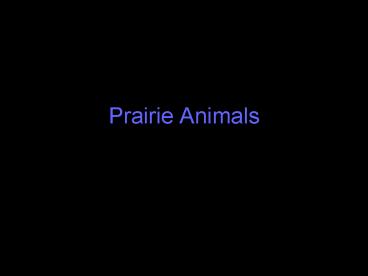Prairie Animals - PowerPoint PPT Presentation
1 / 43
Title:
Prairie Animals
Description:
Prairie Animals Large Grazing Mammals Large grazing mammals have adapted to take advantage of the above ground prairie grasses biomass. Cellulose is hard to digest. – PowerPoint PPT presentation
Number of Views:67
Avg rating:3.0/5.0
Title: Prairie Animals
1
Prairie Animals
2
Large Grazing Mammals
- Large grazing mammals have adapted to take
advantage of the above ground prairie grasses
biomass. Cellulose is hard to digest. - High crowned non-abrasive hypsodont teeth with
crescent shaped ridges of hard enamel that rise
from the gum over time - Multiple storage and fermentation chambers before
the true stomach. The first called the rumen
containing bacterial symbionts that aid in the
digestion of the cellulose. - Undigested food is regurgitated, remasticated,
and swallowed again for more fermentation.
Process called rumination. - Protective horns and/or endurance runners
(pronghorns can run 30 mph for up to 7 miles)
3
(No Transcript)
4
(No Transcript)
5
Small Grazing Mammals
- Lagomorphs do not have the digestive
specializations of the ruminants. - In these animals, small greenish pellets high in
nutrients form in the caecum. These pellets are
voided and reingested. This process is called
Caprophagy.
6
Burrowing Mammals
- Burrowing mammals exploit the below ground
vegetative biomass while taking advantage of the
moderate microclimate - Claws for digging
- Streamline form
7
(No Transcript)
8
(No Transcript)
9
(No Transcript)
10
(No Transcript)
11
(No Transcript)
12
Predatory Mammals
- There are a variety of predatory mammals on the
prairie although many have been displaced by
humans (wolves and bears) - All have keen sense and rely on stealth and speed
in capturing prey
13
(No Transcript)
14
(No Transcript)
15
(No Transcript)
16
Grassland Birds
- Prairie birds fill similar niches as prairie
mammals - Some relying on the grass and forb seed while
other eat the numerous invertebrates living on
the prairie, and others are important predators - They burrow or nest on the ground, and most call
on the wing and have aerial displays for
attracting mates
17
(No Transcript)
18
(No Transcript)
19
(No Transcript)
20
(No Transcript)
21
(No Transcript)
22
(No Transcript)
23
(No Transcript)
24
(No Transcript)
25
(No Transcript)
26
Reptiles
- Being pre-adapted for dry climates, reptiles have
been successful on the great plains. - Predatory.
- Specialized burrowers or burrows users
27
(No Transcript)
28
(No Transcript)
29
(No Transcript)
30
(No Transcript)
31
(No Transcript)
32
(No Transcript)
33
(No Transcript)
34
(No Transcript)
35
(No Transcript)
36
Amphibians
- Being reliant on water resources for breeding and
early development has severely limited the
diversity of amphibians - Opportunistic breeding when rains
- Burrowing adaptations
37
(No Transcript)
38
(No Transcript)
39
(No Transcript)
40
(No Transcript)
41
Other Animals
- Besides the diversity of grasshoppers abundant in
the grassland landscape, there are a number of
other interesting insects and invertebrates.
42
(No Transcript)
43
(No Transcript)































